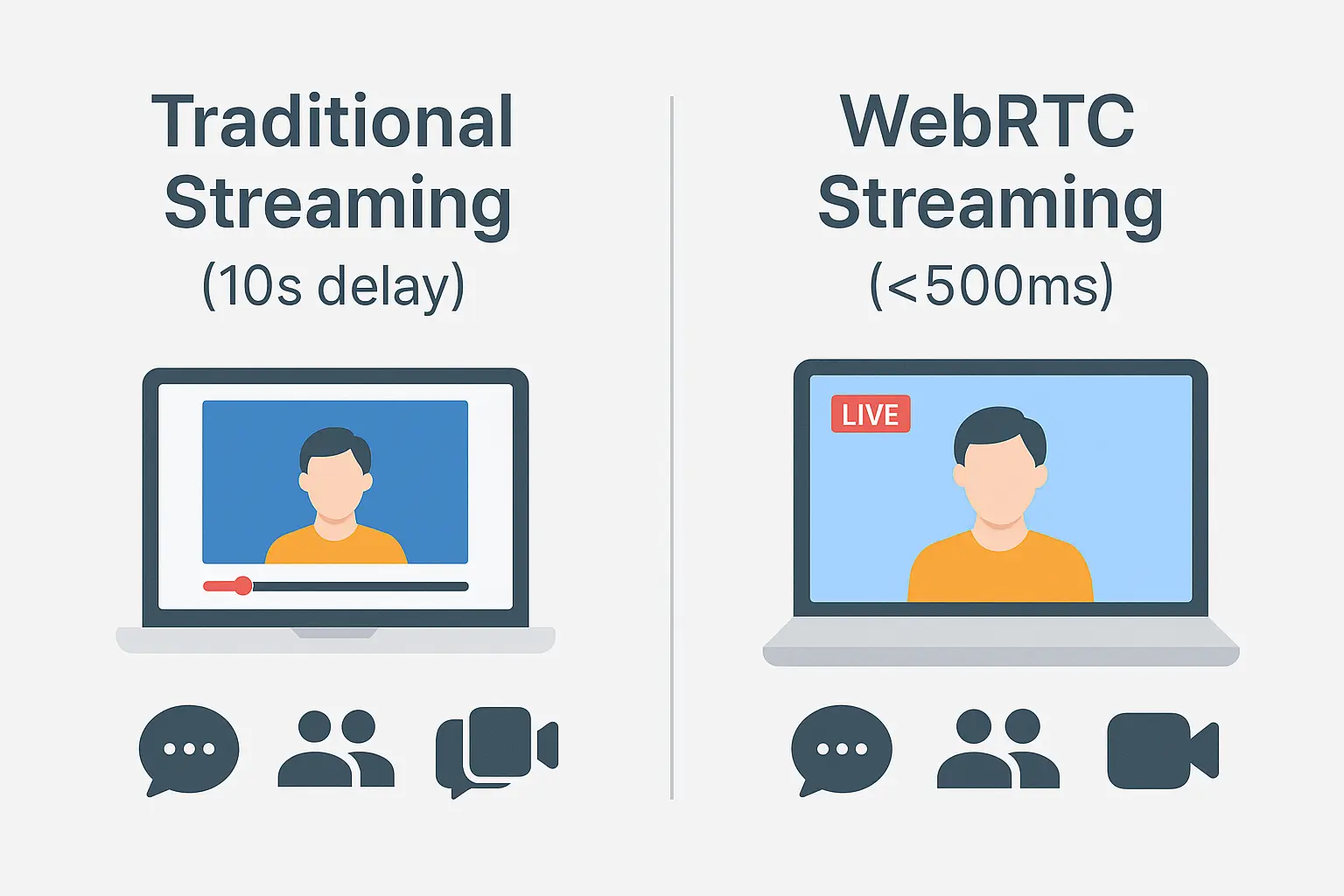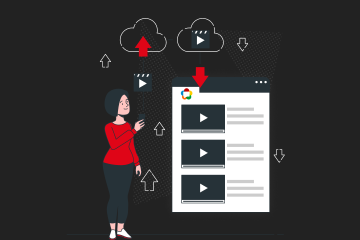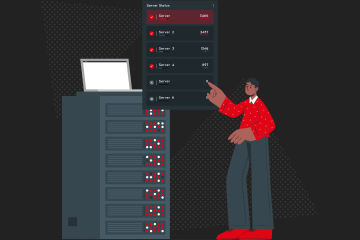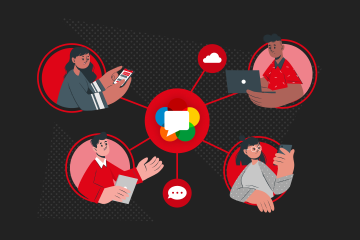In a world where every second counts, delivering real-time video content is no longer a luxury — it’s a necessity. Whether you’re powering an online classroom, launching a telehealth app, or hosting a live event, WebRTC (Web Real-Time Communication) is one of the most powerful tools for ultra-low latency streaming.
If you’re new to WebRTC or want a deeper technical dive, check out our complete guide on how WebRTC works.
In this blog post, we’ll break down the top benefits of using WebRTC for streaming, why it’s a preferred choice over traditional protocols like RTMP and HLS, and how platforms like
Ant Media Server make real-time broadcasting easier and more scalable than ever.
Table of Contents
What is WebRTC?

WebRTC is an open-source project that enables audio, video, and data transmission directly between browsers and mobile apps—in real time. It’s supported by all modern browsers and does not require any third-party plugins or software.
Unlike legacy streaming protocols, WebRTC is built for speed, interaction, and security, which makes it ideal for the next generation of live streaming use cases.
Key Benefits of WebRTC for Streaming
1. Ultra-Low Latency (Sub-500ms)
Latency is one of the most crucial factors in live streaming. Delays of even a few seconds can disrupt interactivity, cause viewer frustration, and degrade the overall user experience. WebRTC offers latency as low as 200 to 500 milliseconds, which is significantly faster than other protocols.
Traditional streaming technologies like HLS introduce delays ranging from 10 to 20 seconds. Even RTMP lags behind with delays of 2 to 5 seconds. In contrast, WebRTC’s real-time performance enables use cases that demand instant feedback and interaction.
Use Case: A telemedicine provider uses Ant Media Server’s WebRTC capabilities to facilitate real-time doctor-patient consultations. The low latency ensures smooth communication, immediate feedback, and a better experience for both parties.
Read the story.
2. No Plugins – Works Directly in the Browser
WebRTC is supported natively in modern browsers like Chrome, Firefox, Safari, and Microsoft Edge. This eliminates the need for users to download or install additional software, significantly lowering barriers to entry.
In today’s mobile-first world, reducing friction is key to increasing engagement and conversion rates. WebRTC provides a seamless, plugin-free experience that enhances accessibility and broadens your reach.
That means your users can join a stream instantly, which improves retention and conversion rates—especially on mobile.
3. Built-in Security and Encryption
WebRTC includes secure communication features by default. It uses Datagram Transport Layer Security (DTLS) and Secure Real-time Transport Protocol (SRTP) to encrypt both data and media streams.
This built-in security ensures that sensitive information, such as medical data or financial transactions, is protected during transmission. It also helps your application stay compliant with data protection regulations like GDPR, HIPAA, and PCI-DSS.
Use Case: A fintech startup relies on Ant Media Server to deliver secure, real-time KYC (Know Your Customer) video calls. The platform’s WebRTC support ensures that data privacy and compliance requirements are met.
4. Adaptive Bitrate for Better Viewing Experience
One of the common challenges in streaming is network inconsistency. Users on slower or unstable connections often experience buffering or quality degradation.
WebRTC solves this with adaptive bitrate streaming. It dynamically adjusts the video quality based on the viewer’s network conditions, ensuring a smooth experience across all devices and locations.
Ant Media Server enhances this feature by offering server-side adaptive bitrate support, making it easier to deliver high-quality video to viewers without overburdening their connections.
5. Scalable with SFU Support
WebRTC started as a peer-to-peer protocol, which works great for one-on-one communications. However, when you need to stream to multiple users simultaneously, a more scalable approach is required.
Enter SFU—Selective Forwarding Unit. An SFU receives media streams from multiple participants and forwards them to others without decoding and re-encoding. This significantly reduces server load and bandwidth requirements.
Use Case: An education platform uses Ant Media Server’s SFU mode to conduct virtual classrooms with over 10,000 concurrent students. The platform maintains real-time interaction with minimal server strain.
Read the story.
6. Cross-Platform Streaming (Mobile, Desktop, Embedded)
WebRTC is inherently cross-platform. It works on desktop browsers, mobile browsers, and native applications. For developers, Ant Media Server offers SDKs for Android, iOS, and JavaScript, making it easy to integrate WebRTC functionality across multiple platforms.
Whether you’re building a consumer-facing mobile app, a B2B dashboard, or an embedded IoT solution, WebRTC allows for consistent, high-quality video experiences everywhere.
Use Case: A leading platform delivering content directly to mobile lock screens redefined live streaming using Ant Media Server SDKs. Read the story.
Real-World Use Cases with Ant Media Server

WebRTC is versatile and supports a wide range of industry applications. Here are some real-world use cases where Ant Media Server is making a difference:
Education (EdTech)
Interactive live classes, online tutoring, and remote examinations require high interactivity and reliability. WebRTC delivers real-time communication, while Ant Media Server ensures scalable and secure delivery.
Healthcare
Telehealth platforms use WebRTC for real-time consultations, diagnostics, and remote monitoring. Ant Media Server’s low-latency architecture helps healthcare providers deliver critical services without delay.
Live Commerce
Retailers use WebRTC for live product demonstrations and flash sales, increasing engagement and conversion rates. Instant viewer interaction and secure payment integration are made easier with Ant Media Server.
eSports and Gaming
Gamers and tournament organizers need real-time synchronization for competitive events. WebRTC ensures players and viewers are perfectly aligned, and Ant Media Server handles the heavy lifting with adaptive streaming and SFU.
Media and News Broadcasting
Remote reporters and journalists can go live from the field using a mobile phone. WebRTC enables instant broadcasting, and Ant Media Server ensures reliable delivery and compatibility with legacy formats like RTMP and HLS.
Why Choose Ant Media Server for WebRTC Streaming?
While WebRTC is powerful, implementing it at scale can be complex. That’s why many developers and enterprises rely on Ant Media Server to bring WebRTC to production effortlessly.
Key Features
- Sub-second latency with WebRTC
- Auto-scalable SFU-based architecture
- Support for protocol conversion including SRT, RTSP, WHIP, UDP, RTMP, Zixi to WebRTC
- SDKs for iOS, Android, JS, Flutter, React Native
- On-premise and cloud deployment options
Final Thoughts
WebRTC is not just a buzzword—it’s the future of real-time video streaming. With its ultra-low latency, native browser support, built-in security, and adaptive streaming capabilities, WebRTC outperforms traditional protocols on every front.
By combining WebRTC with a scalable, developer-friendly solution like Ant Media Server, you can build reliable, secure, and high-performing streaming platforms for any industry or use case.
Whether you’re a startup, enterprise, or developer, now is the perfect time to embrace the power of WebRTC.
And with Ant Media Server, you can unlock the full power of WebRTC with speed, reliability, and developer-friendly tools.
Estimate Your Streaming Costs
Use our free Cost Calculator to find out how much you can save with Ant Media Server based on your usage.
Open Cost Calculator

